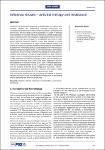Influenza viruses – antiviral therapy and resistance
Duwe, Susanne
Influenza is a serious and frequently underestimated, but vaccine preventable disease. The adamantane derivates rimantadine and amantadine and the neuraminidase inhibitors zanamivir and oseltamivir are the only antiviral drugs currently approved in Europe for therapy and prophylaxis of influenza infections. Resistance to these drugs occurs due to mutations within the therapeutic target proteins M2 ion channel protein and viral neuraminidase. An unexpected occurrence of oseltamivir-resistant seasonal A(H1N1) viruses was detected in winter 2007/2008. The prevalence of these viruses increased rapidly and nearby all viruses circulating during the following seasons were resistant to oseltamivir. The A(H1N1)pdm09 viruses replaced the former seasonal A(H1N1) subtype during the 2009–2010 influenza season. Fortunately, resistance to neuraminidase inhibitors was detected in A(H1N1)pdm09, A(H3N2) and influenza B viruses only sporadically and was treatment related mostly. Comprehensive analyses of circulating viruses showed a high prevalence of A(H3N2) influenza viruses that are resistant to adamantane derivates since 2004/2005 and a progressive trend in the prevalence of resistant viruses up to 100% in following seasons. The M2 ion channel protein of A(H1N1)pdm09 viruses is associated with the Eurasian avian-like swine lineage and thus show “natural” resistance to adamantane derivates. Therefore, only neuraminidase inhibitors are recommended for influenza treatment today. This manuscript summarizes the occurrence and spread of antiviral resistant influenza viruses and highlights the importance for developing and/or approving new antiviral compounds.
Dateien zu dieser Publikation
Keine Lizenzangabe

